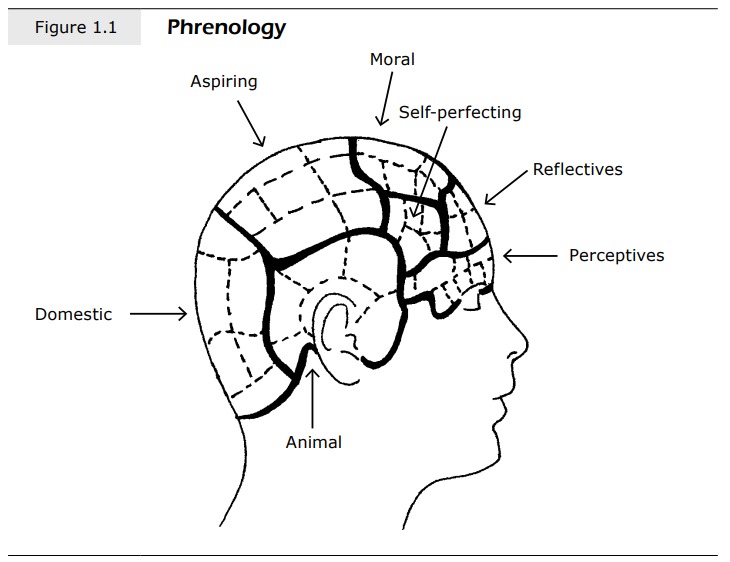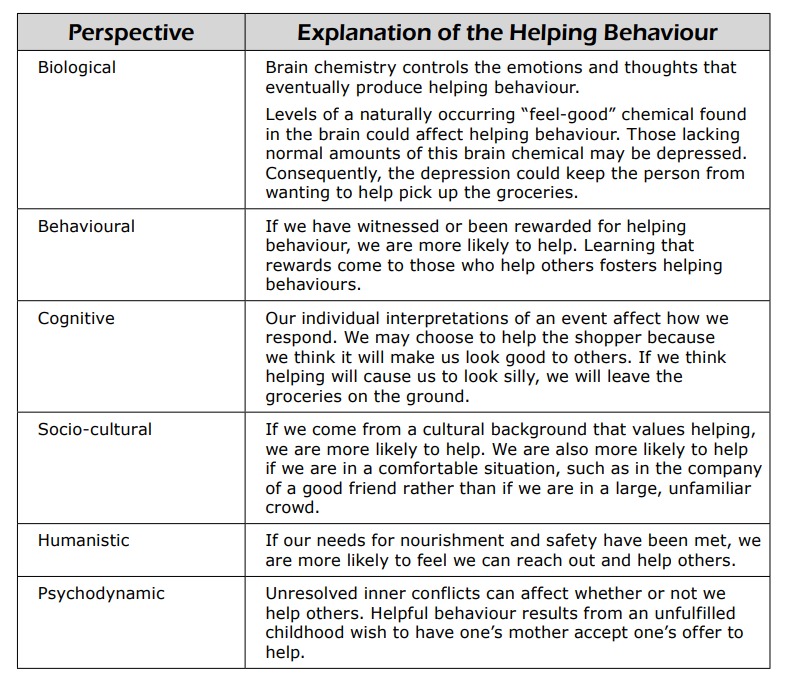There are several major schools of psychology, each with its own theoretical perspective and approach to understanding human behavior and mental processes. And Modern psychology is comprised of six main perspectives used to study behaviour and mental processes. They are the biological, behavioural, cognitive, sociocultural, humanistic, and psychodynamic perspectives. In this lesson, you will learn about these six perspectives and how they compare to each other. We will begin with an overview of when, where, and how psychology began.
History of Psychology [Initial stage of schools of psychology]
To better understand psychology, it is important to see how it began.
Phrenology and Psychophysics
In the early 1800s, there was no distinct science of psychology. The word psychology was used to label a branch of philosophy that concerned itself with human consciousness. Two ancestors of scientific psychology emerged from this branch of philosophy. They are phrenology and psychophysics.
- Phrenology was a theory based on the assumption that bumps on the skull reflected a person’s character or personality traits. The original idea came from Francis Gall. He believed that brain areas, like muscles, should grow when exercised. The shape of the skull should reflect the size or development of the underlying brain tissue, and a bump on the skull might indicate well-developed brain tissue. And so, the skull was mapped and numbered for this purpose. Unfortunately for the phrenologists, bumps on the skull do not reflect the size or development of underlying brain areas. Despite the fact that phrenology was a false science, it foreshadowed the modern psychology belief that different brain regions have distinct skills or functions.

Psychophysics refers to the interaction of the mind (psyche) and the physical world (physics). Psychophysicists were interested in how information from the physical world (light and sound) was translated into mental experiences (brightness and loudness). Modern experimental psychology began with a book published in 1869 by Gustav Fechner.
Major schools of psychology
There are many different schools of psychology, but the most prominent ones include psychoanalytic, cognitive-behavioral, humanistic and social. These different schools of psychology largely have their own approaches to the subjects they focus on. Some of them emphasize learning more about a person’s thoughts and behaviors while others focus on helping people through therapy or advice. let’s know about them in detail.
Wundt’s Psychology and Structuralism [ First school of psychology]
Wilhelm Wundt, who established the first psychology laboratory in 1879 at the University of Leipzig in Germany, is considered the “father of psychology.” He is known for his pioneering work in establishing psychology as a separate field of study. His approach to psychology is known as structuralism, which focused on analyzing the structure of the mind by breaking it down into its basic elements, known as sensations and feelings. Wundt used introspection, the process of observing and describing one’s own thoughts and feelings, as a method of research to study the mind.
Structuralism was the first systematic approach to the study of psychology and laid the foundation for the development of other perspectives in psychology. And it is also known as the first school of psychology.
Wundt’s student Edward Titchener introduced structuralism. This was the first prominent system for organizing psychological beliefs. Structuralists tried to understand the structure of the conscious experience by analyzing the intensity, clarity, and quality of its basic parts. Successful descriptions were the building blocks of consciousness.
The focus was on the “what” of mental processes or thinking, not on the “why” or the “how”.
For example, if structuralists were to look at a blade of grass, they would focus on the intensity of the green, the texture of the blade, and the roughly rectangular shape. This would determine the conscious experience.
James and Functionalism
Another approach to psychology, functionalism, was formulated in the 1890s by William James. He regarded the mind as a process or a function of the organism. This related to Darwin’s theory that humans had evolved from simpler animals. James argued that consciousness must have evolved because it was useful for something; it had a function. For James, the goal of psychology was to study the functions of consciousness or the ways consciousness helps people adapt to their environment.
For example, if functionalists were to look at a blade of grass, they would be interested in why or how someone interprets the blade of grass.
Freud and Psychoanalysis
Sigmund Freud was a mid-century psychiatrist from Vienna. He believed that psychological problems could often be traced to childhood sexual conflicts over issues such as breastfeeding, toilet training, and sexual jealousy centred on the parents. In 1900, he introduced the first complete theory of personality which he called psychoanalysis. It focused on abnormal behaviour and relied on personal observation and reflection instead of controlled laboratory experiments.
Pavlov and Conditioning
The classical studies of animal learning in 1906 by Ivan Pavlov, a Russian physiologist, fuelled a move in psychology toward interest in observable behaviour and away from the self-examination of inner ideas and experiences. His experiments with salivating dogs have become famous. His study of the conditioned reflex provided psychology with a model of learning that is called classical conditioning.
Watson and Behaviourism (schools of Psychology)
Around 1900, the time was right for a new approach to psychology. John B. Watson, an American psychologist, believed that psychology should be defined as the study of behaviour. He called this behaviourism.
It is one of the important schools of Psychology. He completely eliminated introspection (looking inside oneself to gather data about the mind) from psychology and relied solely on the scientific method. This meant studying only things that could be observed and measured.
For Watson, studying the unconscious or anything that you can’t see was of little value. In the past 40 years, this perspective has been modified by other behaviourists, such as B.F. Skinner and Albert Bandura. Today, behaviourism focuses on learning through rewards and observation. By the end of the 1970s, extreme forms of behaviourism were disappearing and humanistic psychology became a dominant perspective.
Maslow, Rogers, and Humanism (schools of Psychology)
Humanistic schools of Psychology focus on inner needs, fulfilment, the search for identity, and other distinctly human concerns. It is less concerned with researching human behaviour than with describing its meaning and purpose.
Abraham Maslow and Carl Rogers emphasized conscious experience as the focus of psychology. They believed that humans have free will in their decision-making and that healthy people strive to reach their full potential. They rejected the idea that humans are controlled by a series of rewards and reinforcements.
Modern Trends of Cognition, Neuroscience, and Socio-cultural Ideas
Cognition emphasizes information processing within humans. It focuses on how people think. More specifically, how they take in, process, store, and retrieve information.
Neuroscience emphasizes the biology of the brain and nervous system. Neuroscientists use a variety of scanning techniques that reveal brain structures and activity.
The socio-cultural perspective examines how thinking and behaviour change depending on the setting or situation.
New Areas of Interest (schools of Psychology)
There are three new areas of interest in psychology. They are behaviour genetics, evolutionary psychology, and positive psychology.
Those studying behaviour genetics focus on the relative effects of our genes and environment on our behaviour. It is a combination of biology and behaviourism.
Those studying evolutionary psychology focus on studying behaviours that helped our ancestors survive. This approach combines biological, psychological, and social aspects of human behaviour.
Martin Seligman began the positive psychology movement in 1998. The focus is on making life more productive and fulfilling, and on identifying and nurturing talent and wisdom. Though it resembles the humanistic perspective, there is, however, a research component.
Eclectic View
No one perspective alone can answer all of the questions that psychology addresses. Each perspective examines behaviour and mental processes from a different point of view. Most psychologists today choose to view behaviour from more than one perspective because they know that this choice will increase their understanding of topics that interest them.
The Six Psychological Perspectives
Perspective 1: The Biological Perspective The biological perspective focuses on how internal physical, chemical, and biological processes affect behaviour. Human genes, hormones, and neurotransmitters in the brain affect human thinking and reactions.

Perspective 2: The Behavioural Perspective The behavioural perspective focuses on how the environment shapes and controls behaviour. Human thought and behaviour are explained in terms of conditioning. Observable behaviours and reactions in response to specific behaviours are examined.

Perspective 3: The Cognitive Perspective The cognitive perspective focuses on how mental processing of information guides behaviour. In other words, how we interpret, process, and remember environmental events. The rules that we use to view the world are important in understanding why we think and behave the way we do.

Perspective 4: The Socio-cultural Perspective The socio-cultural perspective focuses on how thinking and behaviour change depending on the setting or situation. It examines how our thoughts and behaviours vary from people living in other cultures. There is an emphasis on the influence that culture has on how we think and act.

Perspective 5: The Humanistic Perspective The humanistic perspective focuses on how self-image and perceptions guide behaviour. There is a belief that we choose most of our behaviours and that these choices are guided by physiological, emotional, or spiritual needs.
Perspective 6: The Psychodynamic Perspective The psychodynamic perspective focuses on how behaviour comes from hidden or unconscious parts of the mind. The unconscious mind (the part that we don’t have control over or access to) controls many of our thoughts and actions.
Timeline of Psychological Perspectives
The following timeline will show you the time periods in which each of the perspectives mentioned in this lesson had the greatest historical significance in psychology’s development

Now that you have an understanding of how modern psychology came to be, let’s take a look at how each of the modern perspectives would explain a particular behaviour.
Example of the Modern Perspectives {schools of psychology}
The following is an example of how the different perspectives might explain whether or not a person will help a stranger pick up a spilt bag of groceries when given the opportunity.

Lesson Summary
In this lesson, the history of schools of Psychology was explored.
- Psychology came to be in the mid-1800s. It was defined as the science of consciousness.
- By the 1920s, psychologists were more likely to define their field as the science of behaviour. Behaviourists argued that a truly scientific psychologist should report only the data that is actually observed— behaviour. The behavioural era dominated from the 1920s to the 1950s.
- As a reaction to the neglect of the study of the mind, humanistic psychology emerged during the 1960s.
- In the 1970s, cognitive psychology began as computers provided a way to look at mental processing and human information processing.
- In the 1980s, neuroscience emerged as an important source of information about behaviour and mental processes.
- Today, the six major approaches to psychology coexist giving way to an eclectic view. These six approaches, known as perspectives, are as follows:
- Biological
- Behavioural
- Cognitive
- Socio-cultural
- Humanistic
- Psychodynamic




